

|
Back to |
| The Front Page |
| Letters & Opinion |
|
THE VIEW FROM HERE: How will the mega-centers survive and prosper? |
|
|
an editorial by Bob Alman, founding editor; photos by Bob Alman and Croquet Victoria layout by Reuben Edwards Posted August 3, 2007
|
|
When Croquet World Online published our first story in July 2006 on the building of a 12-court mega-centre in a Melbourne suburb scheduled to officially open in September of 2007, we received a number of emails warning of the many dire consequences of the "reckless" expenditure on a single croquet facility of a substantial financial windfall to the Victoria Association from the sale of expensive real estate. There was no business plan, it was said; the siting in a "bad district" of suburban Melbourne on the contaminated site of an abandoned munitions factory was a terrible mistake; and numerous consequential errors had already been made in construction of the clubhouse and lawns. There was no way, it was said, that the facility could ever break even; it would be a continuous and significant drain on the resources of the Victoria state association.

|
| Views of the Victoria Croquet Centre at Cairlea, a suburb of Melbourne. |
Since then, as the opening date draws closer, we have heard rumblings from many voices in Victoria insisting that few of the planning mistakes have been effectively addressed, and new issues have arisen. There doesn't appear to be a publicly available business plan, against which all these warnings and complaints can be measured, and I confess that I haven't tried very hard to get a copy of the business plan, if one exists.
The reason is simple: I don't think a business plan would be very useful at this stage. I was a key player, from almost the beginning, in developing the National Croquet Center in West Palm Beach. At the behest of the founding spirit and chief financial backer, Chuck Steuber, I started working on the development of this Center a full year and a half before the clubhouse opened. As the Director of Corporate Communications, Marketing and Development, I was the de facto club manager for two and a half years - charged, overall, with making the Center happen as a viable financial entity. And I knew, more than anyone, that the creation of a business plan at that stage would be a truly pointless exercise - one which I didn't want to waste precious time on.
The Center was built as a product of the personal vision of Chuck Steuber. He had no formal business plan, but he did have a vivid vision of what the Center should be and the role it should serve both in the local community and in the development of the sport. He supported the aggressive promotion of prestigious international events to put the new facility and USCA croquet in the forefront of the croquet world. He enthusiastically endorsed a comprehensive "Croquet Academy" that embraced the broadest possible range of instruction, competitive events, and casual play catering to everyone and every group from novice players to meeting planners and corporate team builders to casual croquet vacationers and "serious" players from around the globe.
Steuber wanted to reach into the South Florida community with free and low-cost programs for schools and worthy nonprofits calendared for off-peak periods. He and the resident caterer were excited about the plans we laid together for inviting the public to croquet's table with a weekly Sunday brunch open to everyone that would feature entertaining pro-am golf croquet games with local celebrities - thus stimulating the rapid development of a prestigious croquet club boasting fine dining and bar service in an elegant setting, along with Palm Beach style social amenities. His intention was to instantly put the Center into the Palm Beach County spotlight as an extraordinary new sports and recreation showcase and social club. And all of that - of course - would burnish croquet's prospects as a desirable recreation option and fuel the expansion of USCA croquet.
With the title I gave myself - "Director of Marketing, Development, and Community Relations," I saw my job simply as doing the best I could to create in alignment with that brilliant founding vision all the administrative systems and the marketing and sales functions as well as I was able to do so with little staff and less money, making as big a noise as possible in South Florida through networking, personal contacts, and media exposure. I continued to do that basic develpment work for more than a year and a half after Steuber's debilitating stroke, in spite of numerous impediments and the effective cancellation of major components of the founder's vision by a succession of part-time, amateur, offsite appointees of the croquet entities who undoubtedly meant well while they nevertheless wreaked havoc upon the overall development prospects of the Center.

In Victoria, the new centre is the result, almost entirely, of the drive, energy, and determination of one man, the current Secretary of Croquet Victoria and longtime holder of many offices in Australia state and national croquet as well as playing titles. Although none of his private capital is at stake, he is invested considerably in time, effort and political capital. If the Victoria Centre succeeds, he will be a hero on the scale, perhaps, of American's Chuck Steuber. If the Centre fails and threatens the financial health of Croquet Victoria with the building of "Latham's folly," his name will be mud.
In both South Florida and Australia, croquet's 21st Century mega-facilities have already been built. Here's my point: A business plan is usually produced to let you and your investors know whether you have a viable enterprise. After the enterprise is already committed to, it's a different game; you do the best you can with the resources at hand. Balancing expenses and revenue, you achieve black ink as quickly and as painlessly as possible.
The business plan: Who needs it?
In fact, I created in 2001 and refined over the next couple of years a comprehensive development plan for both membership and event sales. Incredibly, this is the only such plan that has ever been produced. And after I left management in the middle of 2003, this plan was progressively and fatally compromised by a succession of managers who had no overall philosophy or plan for development and therefore no roadmap to viability for the Center. The result was that membership, which exceeded the 350 level in the first two years the clubhouse was open, gradually declined to half that level as a direct result of the indifference or incompetence of the onsite managers.
Nevertheless, over that span of time, the event business had been successfully grown by the resident caterer, operating independently of the owners, to produce the majority of the operating revenue. The result of maximizing the growth of the event business has lead, finally, to the dawning recognition that the receipts from outside clients, private parties, corporate meetings, the rental of lawns for croquet association events, and pro shop sales, will never be sufficient to cover the expenses of the Center. In the middle of 2007, it is finally absolutely clear to anyone who cares to look that membership growth is the vital key to achieving financial self-sustainability. I never had any question about this, but I was in a very small minority five years ago.

The truth is that financial self-sustainability for the National Croquet Center should have happened by now. As has been shown in numerous documents shared with the croquet entities, the membership can be grown to a level of 600 at this facility; at that level, membership is by far the dominant factor in the facility's viability - which is consistent with its founding as a development spur for USCA croquet.
Incredibly - in retrospect - the croquet honchos were insisting, loudly, in the middle of 2003 and on through 2004 that "membership is not the priority." Only now can we see that it was always the destiny of this Center to be the largest croquet club in the world; it was always membership dues that would be the main source of operating revenue; now, at last, there is general agreement on this point. Hallelujah!
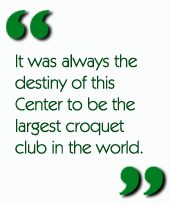
But wait! It's far too soon to celebrate. In fact, the owners have not been able to restore membership growth, even though they will tell you that this the main priority. Why? As arguably the person who knows more about the Center than anyone else alive - as I created, organized and managed all its functions - I swear to you, I cannot answer that question satisfactorily. The answer I have may be accurate, but it's far from satisfactory. The answer is this: the croquet entities are managed by people who know something about local low-stakes croquet clubs, and they try to apply that knowledge to a high-stakes business enterprise that will soon have an operating budget of one million American dollars. They have been unwilling and unable to sufficiently "professionalize" the Center - to ensure that it is managed in accordance with standard business principles and protocols. And I have to report that I see no evidence that there is any immediate change on the horizon. That doesn't mean the news is all bad. Please, read on:
A long view of the issues and the potential
Everyone can agree, surely, that ensuring the health and survival of croquet's two mega-centers is an important objective for the croquet entities in both Victoria and South Florida. It's also important for the overall development of the sport of croquet.
The National Croquet Center was promoted vigorously and successfully in its first two years as "the new mecca" of the sport - a laboratory of innovative programs and events, the place where new things were going to happen to spark the growth of croquet everywhere. Examples of this development were not only the well publicized high-level international competitions produced there, but also the "International Croquet Festival" and "Association Croquet the English Way," which brought competitors at all skills levels from all over the world to the Center to play, to witness, to marvel, and to go back home and boast of having played croquet at "the new mecca."
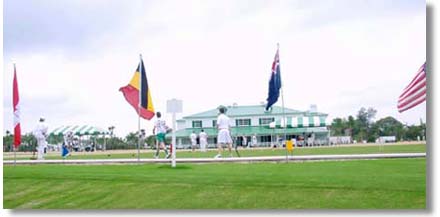
|
| Eleven countries competed in the Golf Croquet World Championship in February 2002, the first major international event at the National Croquet Center, six months before the clubhouse opened. |
It was a fortunate happenstance that the person hired to organize and develop the club initially - namely, Bob Alman - had so little say as to the dimensions and form of the clubhouse. That Center could never have been built "by committee," and Bob Alman would never have had the consensus-building political clout to make it happen. The committee would have said, "No, we can't afford to spend $50,000 on the coffered ceiling," so even though the design motif was Edwardian, a cheaper ceiling would have been substituted, and with all the other practical savings, in architecture, landscape, furnishings, and lawns, the result doubtless would have been an undistinguished, severely compromised venue that could never have attracted the attention - and the business - of top-level meeting planners and corporate groups as fit destinations for their meetings, parties, and team-builders.
A committee would doubtless have reduced the size of the building, arguing for the elimination of the second floor entirely, along with the ballroom that accommodates up to 250 people at rounds-of-eight or ten for elegant dinners or threatre-style meetings. A committee would not have approved the huge state-of-the-art kitchen that can support complex menus for hundreds of people.
All of that - in sum, the creation of something really marvelous, really exceptional - can be achieved only through a visionary force, combined with a substantial purse. Chuck Steuber supplied both in abundance, without compromise, and made possible a unique opportunity for croquet's growth in America.

Alas, Steuber was not able to continue to manage the development of the Center after his debilitating stroke in late 2002. That's when chaos ensued, and the explanation for the chaos can be laid out in fairly simple terms.
The governing bodies of croquet entities are peopled and scaled to the demands of local, low-stakes croquet clubs, dispensing thousands of dollars a year in largess of various kinds to support those clubs - not hundreds of thousands, not millions. The directors are unpaid volunteers who have distinguished themselves in some way in local croquet clubs. For the most part, they would not be invited to sit on the boards of major corporations. But in the croquet world, if they are likely to contribute $50,000, they are already an excellent candidate for a directorship on the board, if not the presidency. The board will be unlikely to notice whether the guy who donated $50,000 made a poor decision that would cost the Center more than $100,000 in its consequences. Such boards have little meaningful knowledge of history - they tend not to connect the dots. They meet perhaps monthly, or bimonthly, and maybe no more than quarterly, and they tend to vote for whatever the officers recommend.
The boards are made up of well-intentioned people who exercise collective responsibility for their organizations - which, in practical terms, means that no direct responsibility has to be exercised at all: it is diffused within the complex and diluting structure of committees, by-laws, and regulated procedures.

But this perennial mismanagement or under-management of the National Croquet Center cannot continue indefinitely. Until the Center is able to be managed competently, USCA donors will have to make up for the annual deficit; when the time comes when they are no longer willing to do that, the owners will have no other recourse but to increase the mortgage. But that's not necessarily a bad thing: Such additional financing may be the very spur the owners need in order to exercise REAL responsibility for the Center's development and financial viability. They would then be forced to acknowledge the mistakes and therefore make the obvious and necessary corrections.
The model is already functional, though clearly flawed
So what is the value of such a "negative" example of development? Simply this: If a magnificent facility can be managed, albeit poorly, to produce significant income from events and parties and to support a large membership club, what might the potential be for future "mega-centers" planned, organized, and built intentionally as profit-making event centers attracting the public in great numbers to book events at magnificent venues with croquet courts - with a small but significant number of them enrolling in the local croquet club established at these venues?
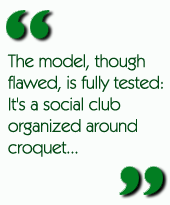
The National Croquet Center model is now fully tested: It's a social club organized around croquet instead of golf. The social aspect actually comes before the croquet. Members are seduced into the croquet - and ultimately into the US Croquet Assocation - with the amenties of a first-rate social club - a beautiful clubhouse, dining and bar service, and a schedule of events catering to all classes of membership, both on the lawns and in the clubhouse. That's the winning formula that the NCC represents - the magic formula that builds the world's first 600-member croquet club.
Where and how the model might be replicated
Let's go back to our initial comparison of these two facilities on opposite sides of the globe. In the upside-down "bizarro world" of Australia (from a Northern Hemisphere viewpoint) croquet in that vast land was organized locally, in a time when there were not the mass communications and transport that made possible the central organization of the US Croquet Association more than a hundred years later, in the late 1970s. Because the USCA was organized and is now based on central control, local growth is often stagnant and uncertain, dependent entirely on whatever inspired or highly motivated individuals might come forward to establish a local club (without much help from the national entities, for the most part).
The US might actually learn from the Australian experience - might learn how to develop LOCAL croquet all across America. It might start with REGIONAL mega-centers that emulate the successful development model demonstrated by the National Croquet Center. As it happens, Australia has six states with separate croquet organizations in each, all united by a relatively weak national association. The USCA has six regions (incorporating Canada and offshore territories). A regional development strategy in the US could be devised to encourage and facilitate establishment of mega-centers in each of them, with the appropriate support - both financial and managerial - of far-sighted local developers.

Whenever and however the National Croquet Center succeeds in spite of itself, developers in upstate New York, in Colorado, in Texas, and in upstate Illinois will begin to regard croquet as their unique draw to build a successful event business. Six lawns would be enough to support huge corporate events and private parties on half-courts, and a social club membership of 300 - with adjacent land, perhaps, in reserve for expansion.
Regional mega-centers could be authorized in any or all of the seven regions of the USCA, with "official" status granted to them in cooperation with developers who would be assured a free hand in providing and directing competent management for building club membership along with the event business that would provide the strongest basis for growth. Residences - townhouses - could be a part of this development. (Can't you envision 36 prime-venue townhouses surrounding the courts as golf links do presently - but on no more than 12 to fifteen acres making up the entire development?) This is an idea whose time WILL come if the croquet entities are willing and able to sustain the founding vision of the NCC as a development strategy for USCA croquet....and simply allow it to happen.
Embryonic regional mega-centers already exist in parts of the US: The Mission Hills club is already being called "National Croquet Center West" informally, for its six lawns and ambitious management in a fast-growing suburb of Palm Springs, California. Pinehurst, North Carolina is already, in spirit if not in lawn capacity, an important regional center for croquet, having mounted and successfully sustained the kind of innovative national and international programs originally created for the National Croquet Center in Florida, before the opportunity was thrown away. Pinehurst has already shown that "official" recognition or help is not required by competent regional volunteers and professionals in the creation of groundbreaking, world-class events and programs.

I cannot speak competently of the potential of the Victoria Centre as a model for development in all the six Australian states, but I would bet that such a model can eventually be developed - over the next five years, say, grounded in the local realities of the Melbourne area marketplace, and based on the physical attributes and capabilities of the venue as it has been built. (An Australian correspondant has told me that the New South Wales state association - a local candidate for the next Australian mega-centre - has seriously explored funding and building a regional headquarters facility.)
As the person who designed, implemented, and managed all the clubhouse and membership operations of the National Croquet Center as well as the membership programs and the national and international events, I can say with confidence that the American model of the 12-lawn facility is valid. To potential developers, I can point to the rapid growth of the club in its first three years, along with the event business. And I can predict with absolute confidence that restoring the original membership development plan of the Center will lead inevitably, within three years, to complete financial viability; and soon afterwards, to significant bottom-line profitability.
Your future is the history you didn't learn
The National Croquet Center opened with a significant handicap - one which looked fatal, for a time. There was virtually NO development capital available for the expenditures on staff, collateral, advertising and promotion that would normally fuel the early growth of a new and unprecedented enterprise in its first few years of operation.
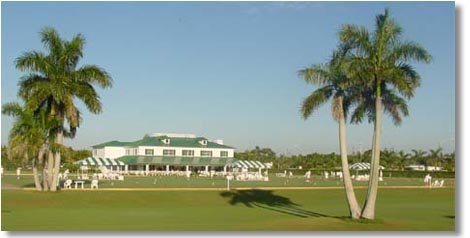
|
| The 12 courts are set early in the morning at Florida's National Croquet Center in the beginning of the club's first season, in the fall of 2002. Photo by Bob Alman. |
The lack of funds was well known to members and to the catering staff. Word quickly spread throughout Palm Beach County that the Center was in financial trouble and would soon close, and the situation was exacerbated by some of the important figures in the croquet establishment who should have known better.
The extent of the organizational disconnect from reality is dramatized by an event witnessed by many at the bar in the membership lounge in the fall of 2002. A key figure on one of the volunteer nonprofit boards announced loudly - and maybe somewhat drunkenly - that the Center was a white elephant and should never have been built. Of course, word of this swept through the relatively small local community of caterers and event planners that the Center would soon go out of business, reinforcing rumors of eminent bankruptcy. This situation made it very difficult to book events six months in advance or more - which is how the major and more profitable events are booked at such a facility. Few meeting planners would take such a risk. So there was no choice but to concentrate on membership - a "depression proof" source of stable income.
Added to this bad PR in the community in 2002 was a 40 percent downturn in incoming convention and tourist trade commonly referred to in the hospitality industry as "the post Nine-Eleven depression." (It took two years for the South Florida hospitality industry to recover.)
Incredibly, the owners of the National Croquet Center appeared to be completely unaware of the devastating effects of the bad PR for which they were themselves responsible and the general economic conditions. They kept telling me that my priority was to generate event sales; while I insisted that the best work I could do in the circumstances was in building membership as the future source of the Center's viability - until financing could be secured for development, and to dispel the negative PR.
This same prominent figure who proclaimed the "white elephant" status of the Center later sealed his fame by announcing solemnly that "there is no difference between marketing and sales." You well may ask, "How can a business enterprise operate at all if the owners do not understand the critical distinction between marketing (media and public relations, writing and distribution of printed materials, networking and exposure events, initial low pricing, etc., etc - everything that makes sales possible) and sales?" The answer is: With great difficulty.

But here's the good news: These thoughtless gaffes would not be made at a professionally managed facility, where the National Croquet Center, guided by competent management (not brilliant, just competent) would have achieved financial self-sufficiency by end of 2006 - as I projected in April of 2003 in a widely distributed memo to the CFA and USCA boards.
Now you see what I meant by the value of the "negative model?" If the Center can survive in the face of such extreme misdirection and incompetence, what might be achieved by regional mega-centers that are intelligently and professionally managed? Canny developers don't have to wait for years on end while the American croquet establishment flounders in chaos. Enough of the potential is already clearly visible to establish the model as viable: a first-class social club and event center with croquet as the unique focus.
The essential shift: from amateur to professional
"It's the most dysfunctional organization with which I have ever been associated." Those words have been spoken - privately, not publicly - by many of the most knowledgeable volunteers in American croquet. Some of them have impeccable credentials in business or specifically in marketing or media - expertise that gives them special insight. But they don't say what they know in any public or official sphere. That would be rude to the well-meaning nice guys who did the damage. So even as "professionals," they tend to operate as amateurs with regard to Center affairs.

Similarly, the "outside" professionals engaged to manage the catering have made comparable observations - privately - as well as the clubhouse staff, from time to time. For the most part (although this is not universally true) they would not want to endanger their salaries by criticizing the NCC or CFA staff or management. (Some of those who spoke out of turn are gone - and among them are some of the brightest and most dedicated staff members.)
One of the hallmarks of the amateur is that he cannot tolerate criticism of any kind; on the other hand, the professional - especially the professional in the area of development - assiduously solicits and encourages responsible criticism ongoingly, and scrupulously engages in self-critique, recognizing that projects and programs can only benefit from such criticism and the correction/improvement that results.
The essence of development is history; the engine of development is self-critique
The amateur will have no overall philosophy of development or any coherent plan; he may have lots of "good ideas," and will want to try them out, but with no sense of responsibility for the outcome. If the outcome is bad - which is most likely, since such people have no ability to "connect the dots" - it will not be their fault; instead of making the obviously called-for correction, they will have a reason for failure, or someone to blame.
These observations apply to many spheres, all over the globe, and to many enterprises. They are universal traits, part of the human condition. Usually, the disasters thus fomented in worthy enterprises are noticed and quickly corrected - or the enterprise so mismanaged goes out of business. Fortunately or unfortunately, there have been no compelling reasons for this to happen either in Palm Beach or Australia, because both facilities were generated from financial windfalls. And both facilities were guided, from their inception, by a single individual generating consensus and committing already-existing or promised financial resources.
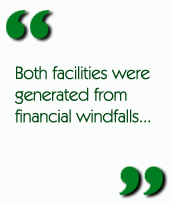
Chuck Steuber in South Florida and George Latham in Victoria carried the ball and made these separate facilities happen. In South Florida, Stueber, unfortunately, suffered a debilitating stroke in late 2002 which took him out of the management picture. Until that point, he maintained a strong hold on management; although he made mistakes - some of them quite costly - he was able to acknowledge them and be fully responsible for them. In my experience while I was working for him, there was no single case in which we could not talk over and agree on an aligned course in whatever area of disagreement came up. But when he exited the picture, chaos ensued. And despite the sincere if often misguided efforts of many, the chaos and the dysfunction have persisted over that entire five years and more. It's really a textbook case of perennial dysfunction. It would make an excellent casebook for study by many nonprofits who suffer the same fate - though perhaps not to the drastic extent we have seen in this case.
Despite all this dysfunction, despite all the terrible problems of incompetent management and under-financing, the unique achievements of the National Croquet Center as an enterprise are significant and unprecedented in the croquet world. The clubhouse opened in May of 2002 with virtually NO development capital and a skeleton staff. I had only one part-time assistant in the clubhouse office, and we did everything that is now done by six full-timers. In spite of that, the membership club got off to a start that can now, in retrospect, be recognized as nothing short of brilliant. After beginning with a strong core of veteran croquet players from the local croquet establishment - more than 100 of them, and others who became members temporarily as a gesture of support - we demonstrated over the next couple of years that we could generate new memberships from the general populace at the rate of 12 to 15 a month, allowing us to have a NET increase in annual membership of more than 100 - a projection that produces 600 members by 2006, if the appropriate level of sales and membership services is maintained.

After 2003, that level of sales expertise and membership services was spectacularly NOT maintained. It declined noticeably. Looking back, almost four years have now been wasted in membership development. That is, instead of advancing, membership went backwards, for the most part, and predictably, because of mismanagement.
How do we make the most of this flawed model in developing croquet as a sport? By combining the best aspects of sound professional business management with the energy, dedication, and enthusiasm of dedicated volunteers. That is the magic formula for developing the croquet super-center franchise in the US. (Super-centers are all the vogue in marketing now, so why not a croquet super-center...?)
Recognizing and accounting for natural stages of growth
Much can be learned from the history of the National Croquet Center's erratic vacillation in price structures and programs. Not knowing this history is the best explanation for the repeat of the same errors and the same kind of errors in cycle after cycle of failed management. (Since the middle of 2003, each of the four generations of club management has lasted anywhere from eight months to a maximum of one year.)
Managers with no coherent, organized development plan or philosophy of development are unable to see that the programs and prices and structures you have at the 200-member level are NOT the same as the ones you will have at the 400 or the 600 level. In many if not most business models, growth reaches a level of "critical mass" when an established momentum of growth actually feeds further growth at a higher rate: That is, when you succeed in growing the base by 10 percent, you actually increase by 20 percent the potential for future growth. Efficiency is multiplied, and the benefits are seen in future growth, which becomes progressively easier.
Amateurs cannot fairly be blamed for failing to grasp the quantum realities of development. But they also should not be asked to manage the Center in the development phase. The truth is that the NCC membership level was very close to a "critical mass" breakthrough at its peak in late 2003: the point at which the sheer numbers virtually guaranteed an ability (always assuming competent management) to produce cost-effective membership services, especially in the vital areas of dining and liquor service in the Members Lounge - the heart and soul of the social club. Instead of taking advantage of this momentum, the subsequent generations of management took membership for granted and neglected the basics.
The unacknowledged quantum theory of development
Development professionals are very aware that the hardest work has to be done in the beginning of the enterprise, when ten inputs produces only one output. This could be expressed in various analytical models, but let's use this familiar description of organizational stages of growth:
CREATION - establishing the initial structures, categories, and pricing at a level to guarantee quick growth.
CONCENTRATION - working hard to generate new memberships supported by novice playing programs and vital social activities centered on dining and bar service.
MOMENTUM - the payoff of good work, when ten inputs now produces ten outputs.
STABILITY - when the enterprise is now more than breaking even on the numbers.
BREAKTHROUGH - when the product of the enterprise is now "scarce," and thus the prices are raised in tandem with market demand, while the income generated from abundant numbers guarantees a sufficient level of activity to maintain excellent services and thus make membership an increasingly scarce and thus valuable commodity. At this level, initiation fees might well be added to the annual memberships for new members, and management can be more selective in choosing new members in order to create and maintain the optimum demographic mix for a vital social club. So "critical mass" means that abundant numbers generate the conditions for improved efficiency, expanded excellence, and a guaranteed level of financial success.

According to the projections I made in mid 2003, the National Croquet Center should now be in the state of financial BREAKTHROUGH. It should have become a highly desirable model to be emulated by developers in other regions of the country doing exactly the same thing with a mix of meetings/parties/events and membership. It can still happen. That's the good news: Breakthrough can be achieved in four years from today - precisely the development time wasted in the indirection and mismanagement of the last four years. The membership development program has already been created and demonstrated to be effective. It only has to be restored and competently managed - beginning today.
Who will save these mega-facilities?
As a fait accompli, these Centers must not be regarded as problems, but as HUGE, UNPRECEDENTED OPPORTUNITIES, in the development (actually the RE-development if you want to be historically accurate) of an under-appreciated sport.
If the croquet entities are unable or unwilling to get their act together, there's a marketplace solution waiting to happen. Although I know nothing of whatever private offers may have been made to the owners of the National Croquet Center, I know for a fact that several individuals of means have been attracted to the Center as a potential for-profit investment. They have witnessed the mushrooming success of the event business there and at the same time they have seen the entirely avoidable mismanagement and consequent decline of the membership club, and they're bright enough to know that with competent management (not brilliant management, just competent management) the Center could produce solid profits as a social club with a premium-level croquet amenity.

I know those private interests out there, because I have consulted confidentially with some potential buyers and investors who have come to ask my opinion, and I have told them exactly what I'm telling you, and what I have told the croquet entities, in vivid detail backed up with solid development history and documentation: that the Center can easily achieve profitability within three or four years if the membership development plan in place five years ago is restored in all it's detail and with competent management.
The "deal" with a buyer from the private sector would be simple, in overview, requiring a few mutual commitments:
* The private investor(s) would want a solid commitment from the croquet entities to remain onsite with the Center continuing to operate as American croquet's headquarters facility, with a fully functioning croquet club, subject to the development oversight of the owners.
* The croquet entities - the Croquet Foundation of America, Croquet Enterprises, and the USCA - would want guarantees that membership fees would never rise above a certain agreed-upon level - not even when the 600 level was reached and the condition of "scarcity" in the marketplace would reasonably price membership at an even higher level - especially in a local "club" marketplace where the Center will ultimately be recognized as "the biggest membership club bargain in South Florida." There would also have to be an agreement to allow low-cost entry-level memberships, so the Center's value as a development strategy for USCA croquet could be maximized. (At the 600 level, the Center would be contributing as much as 15 percent of total national memberships to the USCA.)

For both the private investors and the owners - the Croquet Foundation of America - membership development is the key to achieving break-even and eventual significant profitability. If the Center generates $800,000 in annual expenses and membership dues from all categories contribute $600,000 (in today's dollars), the Center is WAY above the profitability level (assuming the continuation and even the scaling back of fees from private events) and the "critical mass" formula for both membership dues and event fees kicks in. In a market environment of "scarcity" - which every seller of anything desires above all else - memberships are sold at a premium, and only the top-dollar private events will be booked: the event that brings in the most profit, the most publicity, the most prestige, to nail down and perpetuate the Center's reputation at "the best of the best."
The goal ultimately will be to maximize membership dues as the essential key to long-term, depression-proof economic viability. The optimum number of memberships has already been set at somewhere around 600 - that is, one court for each 50 players: a fully manageable number for a 12-court club (if you compare, for example, with the membership and activity volume of tennis clubs). At a regional "mega-center" with six courts, the ideal membership number might be 300.
Capitalizing on a flawed development model
The canny investor can recognize very quickly the essential problems and grasp the ease with which they can be resolved, within a normal development span of three years. This investor/owner can put down his (or her) money in the confidence that he (or she) can now guarantee that a sound development plan for membership will be instantly restored and competently managed.
If the CFA is unwilling to be responsible for the viability of the Center under it's own management - and the evidence mounts yearly that this is the case - a private investor could be the ideal solution: a buyer who could take over the modest mortgage (a half-million dollars, if my information is correct), give the CFA a pile of cash, and contractually commit to maintaining the National Croquet Center as America's headquarters venue.
Both parties could benefit substantially from committing to such a course. The new owners would get a profitable business, and The Croquet Foundation of America would be able to lay down the heavy burden of propping up the Center through generation after generation of insufficient management and would at the same time get a huge inflow of money to pursue its main goal of "education and promotion" of the sport, while still ensuring the continuance of a magnificent headquarters facility.
(And no, the new owner/manager wouldn't have to be Donald Trump, but that's certainly a possibility. The guy knows how to make a profit and how to run a club, and as a matter of fact, some people in his organization have already suggested to him in that past that he should buy the property - which lies conveniently between the Trump golf club in West Palm Beach and fabled Mar-a-Lago, on the island.)
What kind of economic model is the Victoria Centre?
The financial future of the Victoria Centre, at first glance, looks rather bleak. The Centre is designed to serve the needs, primarily, of only one of the states, in an admittedly very sporty country, but one with a population less than one-tenth that of the United States. (By that measure, US croquet is spectacularly undeveloped, because the national association of each country has about the same number of members.) The function spaces in Victoria are not large and do not appear to be especially beautiful, and cannot be expected to generate much revenue. It's hard to envision a local membership development strategy that would easily produce 600 members; and even if that could be achieved, the croquet culture and the facility would probably be unable to generate much more than $250 for a full membership. It doesn't add up - not yet, anyway.
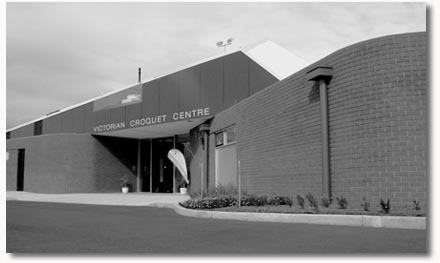
|
| Black and white view of the Victoria Croquet Centre by Adrian Masterman |
But it's useful to recall that only five years ago, no one was willing to create any kind of business plan for Florida Center. In the next few years, presumably, all the defects of the Victoria Centre will have been corrected, the membership club will be growing at some now-unknown and probably unpredictable rate, and inevitably, some kind of balance will have been achieved between croquet-related events and "public" functions for hire. Just as no rational business plan could have been developed for the National Croquet Center, no reasonable plan for the Victoria Centre is on the near horizon. It will have to be discovered in the course of the first few seasons. The die is cast. Something is going to happen at the Victoria Centre over the course of the next few years.
Both of these facilities are visionary. They are similar in dimension, but their character and potential cannot really be compared. The Victoria Centre is less expensive to run, but probably also has a lower potential in income from both membership and outside functions. (The function space is limited to groups of 100 or fewer.) Melbourne cannot draw upon a huge potential market for incoming conventions and corporate meetings, as can South Florida. Melbourne has nothing like the reservoir of ridiculously wealthy patrons of nonprofits that Palm Beach has, willing to spend a lot of money on "elegant" events that feature state-of-the-art croquet lawns. "Corporate croquet" is not a hot item on the activity menus of meeting planners in Australia. And even if Melbourne had such opportunities, the Victoria Centre is not built to their standards. The ambiance of the National Croquet Center, after all, is that of Edwardian splendor, fitted out with coffered ceilings and genuine antiques and plush leather chairs and Persian rugs, and.... The architecture and decor of the Victoria Centre are more akin to the stripped-down utility of a MacDonald's franchise.
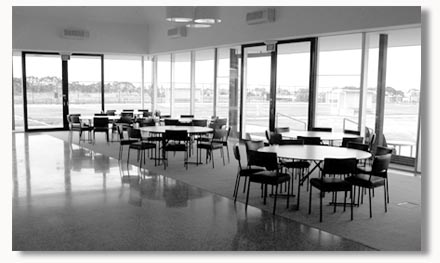
|
| Another view of the Victoria Croquet Centre by Adrian Masterman |
For the Victoria Centre, only time - and intention and hard work and good management, one hopes - will tell. Although the National Croquet Center in West Palm Beach provides no exact precedent for the Victoria Centre, it at least does show that visionary goals can be achieved in unexpected, unpredictable ways.
My viewpoint originates here, in Palm Beach. I stand behind all the facts and projections in this editorial and back them up with documentation and a near 100-percent knowledge of Center operations over the last 6 1/2 years - not just from managing the club for its first 2 1/2 years, but also from having an office onsite for much of the subsequent time, as well as being a key member of the Executive board and various committees. I would stake my reputation (and in fact I already have!) on the potential of this Center, which grew out of Chuck Steuber's vision and which is destined to chart a new future for the development of the sport - if only the owners will allow it to happen!
We must leave it to the officers of the Victoria Association to chart the future development of the Victoria Centre. If a viable business plan can be created and realized for this facility, the croquet world will then have two distinctly different models for development to stimulate the growth of the sport in many, many different countries of the world.
Not since Wimbledon, more than 130 years ago, have croquet-centered venues of these dimensions been built to spur the development of the sport. When Wimbledon failed, organized croquet suffered a long decline, only to recover, somewhat, at the end of the 19th Century with the establishment of the Croquet Association in England. Whether, how, and how soon these trail-blazing facilities of the 21st Century succeed are matters of huge consequence in the future of the sport.
It's your turn to speak in The ForumThis editorial is meant to set the stage for a continuing, inclusive conversation. We welcome voices from all continents and all points of view on all the facts and issues raised here. Anyone and everyone may comment at any length in the DISCUSSION FORUM linked here. The link takes you to the Index of the FORUM, where you can read the INTRODUCTION to the "Mega-Center Development" conversation and then hit the SUBMIT A POSTING link at the top of the index to bring up the posting menu, which begins by asking you to title your own posting as you would like it remain online indefinitely in the Index. Let us hear from you!
- Bob Alman, Founding Editor
Croquet World Online Magazine